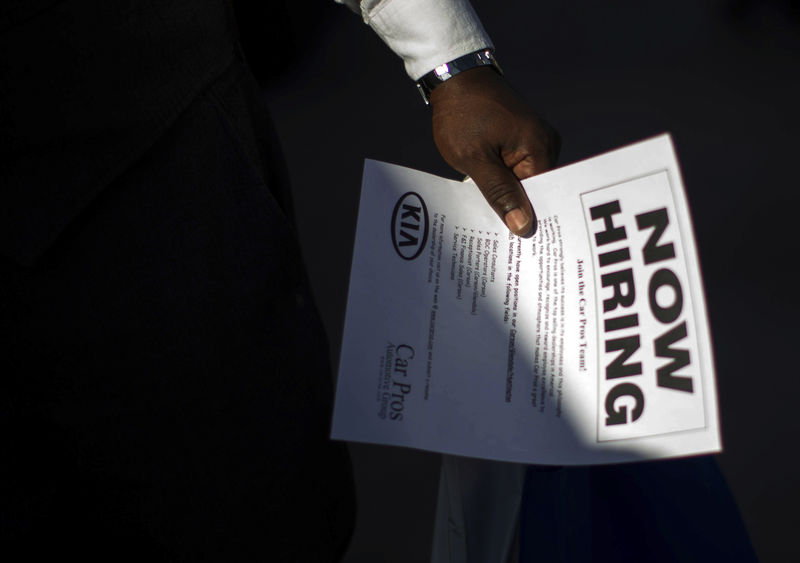By Lucia Mutikani
WASHINGTON (Reuters) - The number of Americans filing applications for unemployment benefits surged to near a 1-1/2-year high last week, but economists dismissed the jump as a fluke and said temporary factors, including a partial government shutdown, were to blame.
A strike by teachers in California, cold weather and difficulties adjusting the data around moving holidays like Martin Luther King Jr. Day also likely were factors in the spurt in claims reported by the Labor Department on Thursday.
"We are skeptical the rise could reflect a true weakening in the labor market given that there are few other signs of weaker labor markets in January," said John Ryding, chief economist at RDQ Economic in New York. "Nonetheless, if we maintain this higher level of jobless claims in the coming weeks, that would indicate a pickup in layoff activity."
Initial claims for state unemployment benefits jumped 53,000 to a seasonally adjusted 253,000 for the week ended Jan. 26, the highest level since September 2017, the Labor Department said. The rise was also the largest since September 2017.
Claims dropped to 200,000 in the prior week, which was the lowest level since October 1969. Economists polled by Reuters had forecast claims rising to only 215,000 in the latest week.
The claims data covered the Martin Luther King Jr. holiday, which occurred later this year than in the past. Economists believe non-federal government workers who were temporarily unemployed during the longest government shutdown in the country's history likely helped to boost claims last week.
The surge in claims came amid a recent deterioration in business and consumer confidence, which was partly blamed on a five-week government shutdown that has since ended.
The Federal Reserve on Wednesday kept interest rates steady but said it would be patient in lifting borrowing costs further this year in a nod to growing uncertainty over the economy's outlook. The U.S. central bank removed language from its December policy statement that risks to the outlook were "roughly balanced."
The four-week moving average of initial claims, considered a better measure of labor market trends as it irons out week-to-week volatility, rose 5,000 to 220,250 last week.
The claims data has no bearing on January's employment report, which is scheduled for release on Friday, as it falls outside the survey period. According to a Reuters survey of economists, non-farm payrolls likely increased by 165,000 jobs in January after jumping by 312,000 in December.
The 35-day government shutdown is not expected to have an impact on January's job growth, as workers who were furloughed will be paid retroactively together with colleagues who worked without pay. However, those workers who stayed at home during the shutdown are expected to temporarily push up the unemployment rate in January.
The dollar fell against most major currencies, dropping to a two-week low versus the yen, pressured by the Fed's cautious economic outlook. U.S. Treasury yields fell, while stocks on Wall Street were trading mostly higher.
STEADY WAGE GAINS
Underscoring the labor market's strength, another report on Thursday from the Labor Department showed its Employment Cost Index, the broadest measure of labor costs, increased 0.7 percent in the fourth quarter after rising 0.8 percent in the July-September period.
The fourth quarter rise lifted the year-on-year rate of increase in labor costs to 2.9 percent, the biggest gain since June 2008, from 2.8 percent in the 12 months through September.
Wages and salaries, which account for 70 percent of employment costs, rose 0.6 percent in the fourth quarter after advancing 0.9 percent in the prior period. They were up 3.1 percent in the 12 months through December.
That was the biggest increase since June 2008 and followed a 2.9 percent gain in the year through September.
"It supports our view that the tightness in the labor market is generating upward pressure on compensation," said Daniel Silver, an economist at JPMorgan (NYSE:JPM) in New York.
While the labor market is on solid footing, manufacturing appears to be slowing. A third report on Thursday showed the MNI Chicago business barometer dropped 7.1 points to a reading of 56.7 in January as new orders tumbled to a two-year low. The survey's measure of production dropped to a 10-month low.
There was some good news on the housing market. The Commerce Department reported new home sales vaulted 16.9 percent in November to a seasonally adjusted annual rate of 657,000 units. The surge erased October's 8.3 percent plunge in single-family home sales.
The November home sales report was delayed by the government shutdown, which affected the Commerce Department.
The housing market struggled in 2018, weighed down by acute shortages of homes for sales, which boosted prices, as well as higher mortgage rates. But there are glimmers of hope as house price inflation has slowed significantly and mortgage rates have eased after shooting up last year.
Supply, however, still remains tight.

"We expect a further rise in new home sales during 2019 as homebuyers look to new builds, with inventory conditions for existing homes still extremely tight," said Ben Ayers, senior economist at Nationwide in Columbus, Ohio.